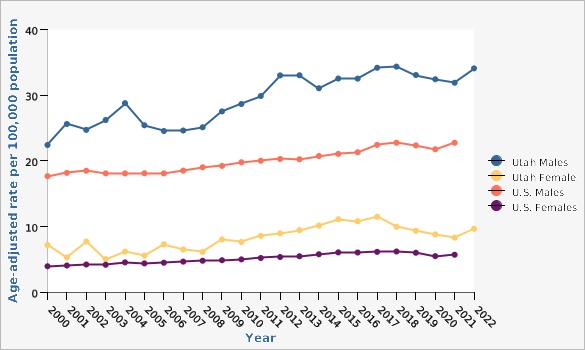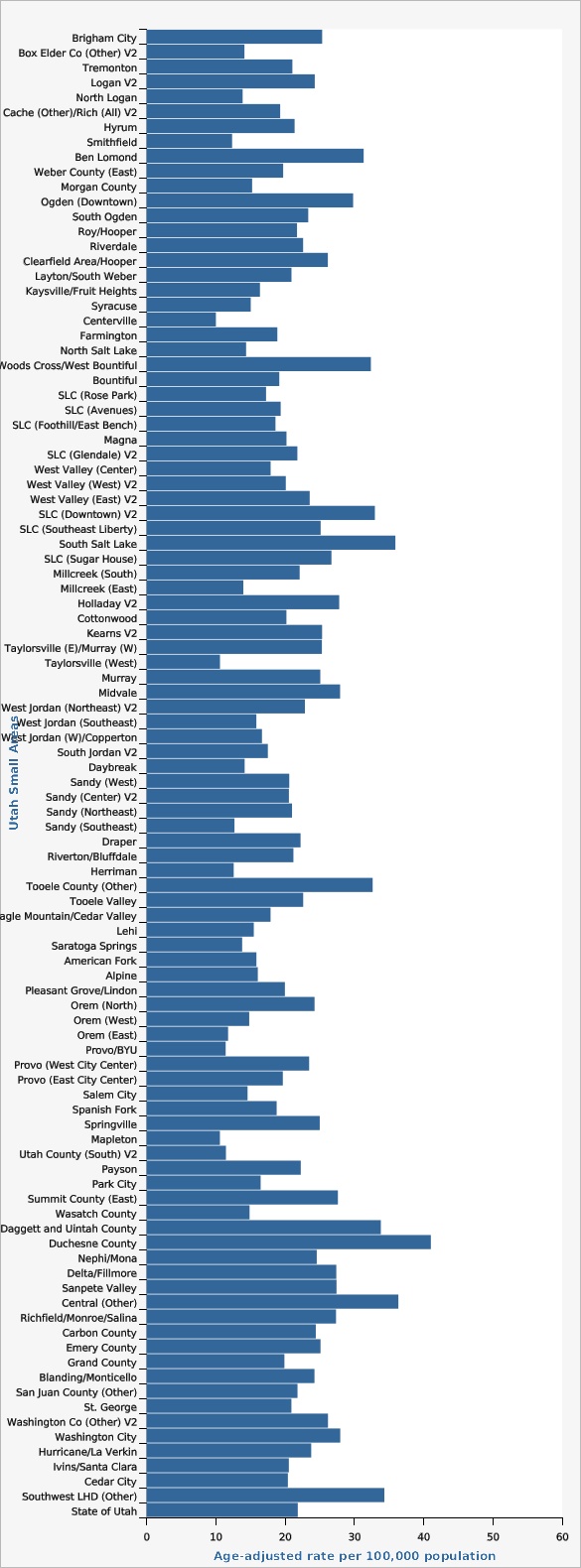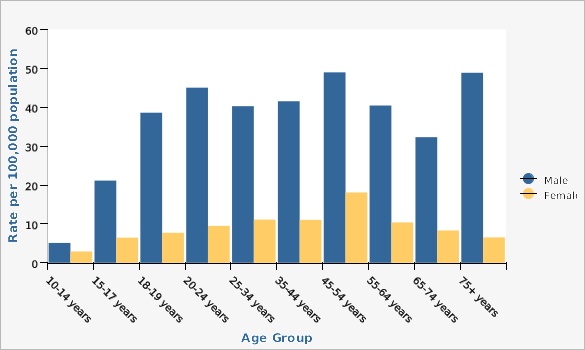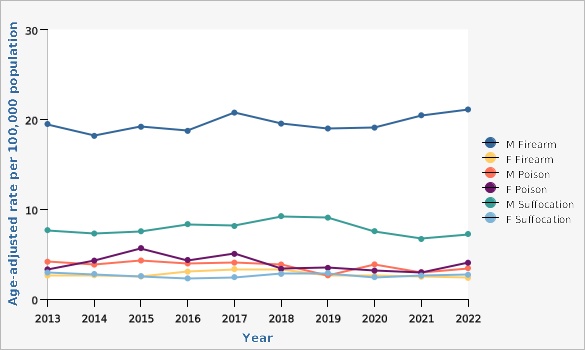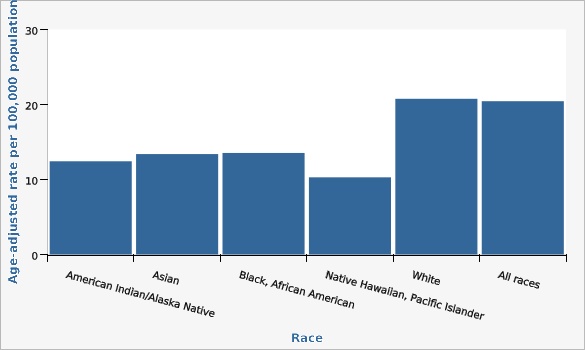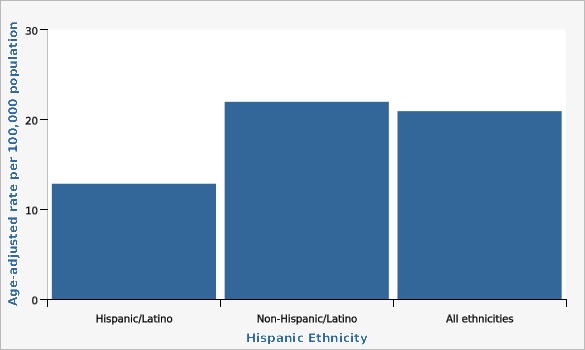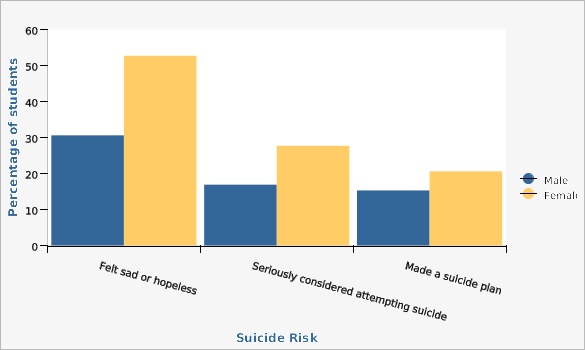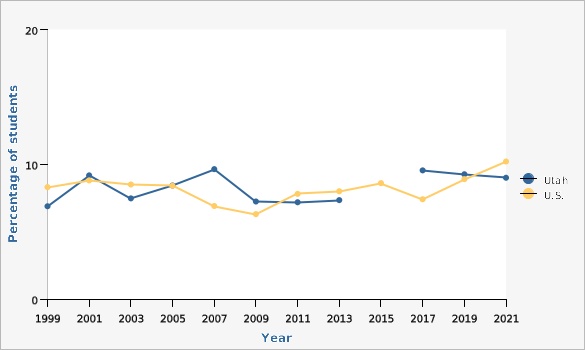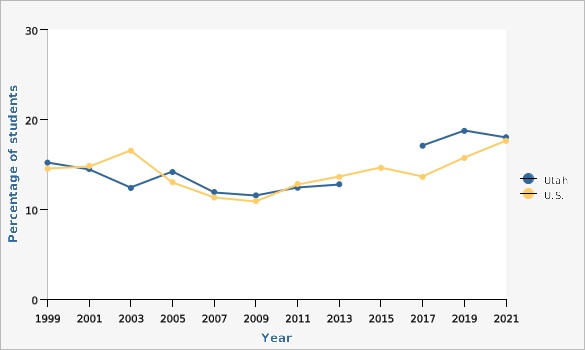Complete Health Indicator Report of Suicide
Definition
Suicide Death Rate: Number of resident deaths resulting from the intentional use of force against oneself per 100,000 population (ICD-10 codes X60-X84, Y87.0, *U03). Suicide Risk Among Students: Percentage of students who reported a suicide risk factor (felt sad or hopeless, seriously considered attempting suicide, made a suicide plan, or attempted suicide) during the past 12 months.Numerator
Suicide Death Rate: Number of deaths resulting from the intentional use of force against oneself. Suicide Risk Among Students: Number of students who reported a suicide risk factor (felt sad or hopeless, seriously considered attempting suicide, made a suicide plan, or attempted suicide) during the past 12 months.Denominator
Suicide Death Rate: Total number of persons in the population of Utah. Suicide Risk Among Students: Number of surveyed Utah high school students.Data Interpretation Issues
ICD stands for the International Classification of Diseases. It is a coding system maintained by the World Health Organization and the U.S. National Center for Health Statistics used to classify causes of death, such as suicide, on death certificates. These codes are updated every decade or so to account for advances in medical technology. The U.S. is currently using the 10th revision (ICD-10) to code causes of death and hospital emergency department visits. The Youth Risk Behavior Survey includes surveys of representative samples of 9th-12th grade students in public schools. The survey is conducted in odd years. Data are self-reported and subject to recall bias. Data are from a sample survey and subject to selection bias. Comparisons of annual rates must be interpreted cautiously as methods used to collect data vary from year to year. With the introductions of active parental consent for Utah school surveys between 1997 and 1999, the student response rate for the survey decreased significantly. Participation in 2015 was too low to meet the reporting threshold as defined by CDC, so results for that year are not available.Why Is This Important?
From 2020 to 2022, the age-adjusted suicide rate in Utah was 20.85 per 100,000 persons, with an average of 670 suicides per year. There were 717 suicide deaths in 2022. In 2022, suicide was the leading cause of death for Utahns ages 10 to 17 and 18-24. It was the second leading cause of death for ages 25 to 44 and the fifth leading cause of death for ages 45-64. Overall, suicide was the tenth leading cause of death for Utahns (age-adjusted rate). Suicide deaths are only part of the problem. More people are hospitalized or treated in emergency rooms for suicide attempts than are fatally injured. In 2022, 12 Utahns were treated for self-inflicted injuries every day (3,121 treat-and-release emergency department visits plus 1,311 total hospitalizations). According to the 2021 Youth Risk Behavior Survey, in the 12 months preceding the survey, Utah high school students reported the following: 41.5% felt sad or hopeless, 22.5% seriously considered attempting suicide, 18% made a suicide plan, 9% attempted suicide one or more times, and 2.7% had a suicide attempt that required medical attention. The 2023 Prevention Needs Assessment data indicate that overall, 27% of Utah students in grades 8, 10, and 12 reported experiencing serious mental illness. Students were also asked social isolation questions and reported the following: 14.2% felt moderately socially isolated and 9.2% felt severely socially isolated. Additionally, 7.3% reported having attempted suicide in the past year and 18.9% reported having seriously considered attempting suicide in the past year. All suicide attempts should be taken seriously. Suicide attempt survivors are often seriously injured, are likely to have depression and/or another mental health disorder, and are at an increased risk for suicide. Suicidal behavior is a serious and complex public health issue that takes an enormous toll on communities with both economical and human costs.Other Objectives
{{style color:#003366 Healthy People 2030 Objective IVP-41:}}[[br]] Reduce emergency department visits for nonfatal intentional self-harm injuries[[br]] '''U.S. Target:''' 144.7 emergency department visits per 100,000 population[[br]] '''State Target:''' 91.7 emergency department visits per 100,000 population[[br]] [[br]] {{style color:#003366 Healthy People 2030 Objective MHMD-2:}}[[br]] Reduce suicide attempts by adolescents[[br]] '''U.S. Target:''' 1.8 suicide attempts per 100 population[[br]] '''State Target:''' 1.9 suicide attempts per 100 populationHow Are We Doing?
The 2022 Utah age-adjusted suicide rate was 21.9 per 100,000 population. Males (34.1 per 100,000 population) had a significantly higher age-adjusted suicide rate compared to females (9.7 per 100,000 population). In Utah from 2020 to 2022, males had significantly higher suicide rates than females in every age group. Males aged 45-54 had the highest suicide rates among males (49 per 100,000 population). Females aged 45-54 had the highest suicide rates among female age groups (18.1 per 100,000 population). From 2020 to 2022, TriCounty, Central Utah, Southwest, and Weber-Morgan local health districts had significantly higher age-adjusted suicide rates compared to the state rate. Among Utah Small Areas, Duchesne County, Central (Other), South Salt Lake, Southwest LHD (Other), Daggett and Uintah County, and Salt Lake City (Downtown) had significantly higher age-adjusted suicide rates compared to the state rate during 2018-2022.How Do We Compare With the U.S.?
The Utah suicide rate has been consistently higher than the national rate. In 2021 (the most recent national-level data year available, data from the National Center for Health Statistics), the age-adjusted suicide rate for the U.S. was 14.04 per 100,000 population, while the Utah suicide rate was 20.05 per 100,000 population during the same year. Utah had the 14th-highest age-adjusted suicide rate in the U.S. in 2021.What Is Being Done?
The Utah Department of Health and Human Services Violence and Injury Prevention Program (VIPP) is funded by the U.S. Centers for Disease Control and Prevention (CDC) to implement the Utah Violent Death Reporting System (UTVDRS). UTVDRS is a data collection and monitoring system that will help Utahns to better understand the public health problem of violence by informing decision-makers about the magnitude, trends, and characteristics of violent deaths such as suicide, and to evaluate and continue to improve state-based violence prevention policies and programs. Data are collected from the Office of the Medical Examiner, Vital Records, and law enforcement agencies and are linked together to help identify risk factors, understand circumstances, and better characterize perpetrators of violent deaths. The VIPP is also funded by the CDC to improve the timeliness of syndromic surveillance data of nonfatal suicide-related outcomes, including nonfatal self-directed violence and suicidal ideation. The VIPP partners with multiple state and local agencies including the Division of Substance and Mental Health (DSAMH), the Utah State Board of Education, the Office of the Medical Examiner, the National Alliance on Mental Illness Utah, local health departments, and many others to facilitate and build capacity for suicide prevention efforts across the state. VIPP also participates in the Utah Suicide Prevention Coalition, a state-level multi-sectoral group, and its seven workgroups that focus on specific populations and topic areas.Available Services
All Counties, 24 Hours: [[br]] Suicide Crisis Lifeline at 988 Safe UT App Mobile Crisis Outreach Team (MCOT) - for both Salt Lake County and statewide[[br]] 801-587-3000 The Trevor Project Trans Lifeline, (877) 565-8860 Live on Utah National Alliance on Mental Illness (NAMI) Utah American Foundation for Suicide Prevention Utah Poison Control CenterHealth Program Information
The mission of the Violence and Injury Prevention Program (VIPP) is to be a trusted and comprehensive resource for data and technical assistance related to violence and injury. Through education, this information helps promote partnerships and programs to prevent injuries and improve public health. The VIPP envisions a Utah where communities thrive and Utahns feel connected, safe, and supported. To realize this vision and mission, VIPP's strategic plan utilizes a Shared Risk and Protective Factor framework that includes interventions across the Social Ecological Model including primary, secondary, and tertiary prevention strategies. As such, VIPP has identified these super factors that will guide their work over the next five-plus years: * Healthcare Access: Improve access and utilization to physical and behavioral healthcare. * Economic Stability: Improve socio-economic conditions for Utahns. * Social Norms: Encourage social norms that promote safety and health. * Built Environment: Enhance the physical environment to improve safe and healthy living. * Connectedness: Promote individual, family, and community connectedness.Related Indicators
Relevant Population Characteristics
Males had a significantly higher suicide rate compared to females in every age group in 2020-2022.Related Relevant Population Characteristics Indicators:
Risk Factors
Many conditions and stressors may be related to suicide including: *Previous suicide attempt(s) *History of depression or other mental illness *Alcohol or drug abuse *Family history of suicide or violence *Physical illness *Easy access to lethal means of suicide[[br]] [[br]] Source: [https://www.cdc.gov/suicide/factors/index.html] (accessed 12/28/2023)Related Risk Factors Indicators:
Health Status Outcomes
Suicide is death caused by injuring oneself with the intent to die. A suicide attempt is when someone harms themselves with the intent to end their life, but they do not die as a result of their actions. Those who attempt suicide and survive may have serious injuries like broken bones, brain damage, or organ failure. Also, people who survive often have depression and other mental health problems. Source: [https://www.cdc.gov/suicide/facts/index.html] (accessed 12/28/2023)Related Health Status Outcomes Indicators:
Graphical Data Views
| UT M, UT F, US M, US F | Year | Age-adjusted rate per 100,000 population | Lower Limit | Upper Limit | Numer- ator | Denom- inator |
|---|---|---|---|---|---|---|
Record Count: 90 | ||||||
| Utah Males | 2000 | 22.4 | 19.4 | 25.7 | 222 | 1,124,675 |
| Utah Males | 2001 | 25.6 | 22.5 | 29.1 | 263 | 1,144,533 |
| Utah Males | 2002 | 24.7 | 21.7 | 28.1 | 259 | 1,165,962 |
| Utah Males | 2003 | 26.2 | 23.1 | 29.6 | 281 | 1,184,270 |
| Utah Males | 2004 | 28.8 | 25.5 | 32.3 | 309 | 1,204,831 |
| Utah Males | 2005 | 25.4 | 22.4 | 28.7 | 282 | 1,232,978 |
| Utah Males | 2006 | 24.6 | 21.6 | 27.8 | 274 | 1,267,516 |
| Utah Males | 2007 | 24.6 | 21.8 | 27.7 | 293 | 1,305,074 |
| Utah Males | 2008 | 25.1 | 22.3 | 28.1 | 311 | 1,337,398 |
| Utah Males | 2009 | 27.5 | 24.6 | 30.7 | 346 | 1,367,912 |
| Utah Males | 2010 | 28.7 | 25.7 | 31.8 | 369 | 1,394,146 |
| Utah Males | 2011 | 29.9 | 26.8 | 33.1 | 378 | 1,414,049 |
| Utah Males | 2012 | 33.0 | 29.9 | 36.4 | 429 | 1,434,801 |
| Utah Males | 2013 | 33.0 | 30.0 | 36.3 | 444 | 1,457,715 |
| Utah Males | 2014 | 31.0 | 28.1 | 34.3 | 417 | 1,477,790 |
| Utah Males | 2015 | 32.5 | 29.6 | 35.7 | 459 | 1,501,242 |
| Utah Males | 2016 | 32.5 | 29.6 | 35.7 | 459 | 1,532,337 |
| Utah Males | 2017 | 34.2 | 31.2 | 37.4 | 499 | 1,562,978 |
| Utah Males | 2018 | 34.4 | 31.4 | 37.5 | 515 | 1,588,994 |
| Utah Males | 2019 | 33.1 | 30.2 | 36.1 | 513 | 1,613,538 |
| Utah Males | 2020 | 32.4 | 29.6 | 35.4 | 515 | 1,652,432 |
| Utah Males | 2021 | 31.9 | 29.2 | 34.8 | 509 | 1,681,294 |
| Utah Males | 2022 | 34.1 | 31.3 | 37.1 | 561 | 1,711,388 |
| Utah Females | 2000 | 7.2 | 5.6 | 9.1 | 72 | 1,119,827 |
| Utah Females | 2001 | 5.3 | 4.0 | 7.0 | 53 | 1,139,182 |
| Utah Females | 2002 | 7.7 | 6.1 | 9.7 | 77 | 1,158,853 |
| Utah Females | 2003 | 5.0 | 3.8 | 6.6 | 54 | 1,175,867 |
| Utah Females | 2004 | 6.2 | 4.8 | 7.9 | 68 | 1,196,749 |
| Utah Females | 2005 | 5.6 | 4.2 | 7.2 | 62 | 1,224,741 |
| Utah Females | 2006 | 7.3 | 5.8 | 9.1 | 83 | 1,257,991 |
| Utah Females | 2007 | 6.5 | 5.1 | 8.2 | 75 | 1,292,672 |
| Utah Females | 2008 | 6.1 | 4.8 | 7.7 | 73 | 1,325,631 |
| Utah Females | 2009 | 8.0 | 6.5 | 9.8 | 97 | 1,355,509 |
| Utah Females | 2010 | 7.6 | 6.2 | 9.4 | 98 | 1,381,267 |
| Utah Females | 2011 | 8.6 | 7.0 | 10.3 | 113 | 1,400,748 |
| Utah Females | 2012 | 9.0 | 7.4 | 10.8 | 116 | 1,419,345 |
| Utah Females | 2013 | 9.4 | 7.8 | 11.3 | 126 | 1,441,058 |
| Utah Females | 2014 | 10.1 | 8.5 | 12.0 | 138 | 1,460,537 |
| Utah Females | 2015 | 11.1 | 9.4 | 13.1 | 150 | 1,482,384 |
| Utah Females | 2016 | 10.8 | 9.1 | 12.7 | 153 | 1,511,904 |
| Utah Females | 2017 | 11.5 | 9.8 | 13.4 | 164 | 1,540,562 |
| Utah Females | 2018 | 10.0 | 8.4 | 11.7 | 149 | 1,566,159 |
| Utah Females | 2019 | 9.4 | 7.8 | 11.0 | 141 | 1,589,845 |
| Utah Females | 2020 | 8.8 | 7.4 | 10.4 | 136 | 1,632,391 |
| Utah Females | 2021 | 8.3 | 7.0 | 9.9 | 134 | 1,662,224 |
| Utah Females | 2022 | 9.7 | 8.2 | 11.3 | 156 | 1,693,372 |
| U.S. Males | 2000 | 17.7 | 23,618 | 138,458,150 | ||
| U.S. Males | 2001 | 18.2 | 24,672 | 139,891,492 | ||
| U.S. Males | 2002 | 18.5 | 25,409 | 141,230,559 | ||
| U.S. Males | 2003 | 18.1 | 25,203 | 142,428,897 | ||
| U.S. Males | 2004 | 18.1 | 25,566 | 143,828,012 | ||
| U.S. Males | 2005 | 18.1 | 25,907 | 145,197,078 | ||
| U.S. Males | 2006 | 18.1 | 26,308 | 146,647,265 | ||
| U.S. Males | 2007 | 18.5 | 27,269 | 148,064,854 | ||
| U.S. Males | 2008 | 19.0 | 28,450 | 149,489,951 | ||
| U.S. Males | 2009 | 19.2 | 29,089 | 150,807,454 | ||
| U.S. Males | 2010 | 19.8 | 30,277 | 151,788,777 | ||
| U.S. Males | 2011 | 20.0 | 31,003 | 153,200,058 | ||
| U.S. Males | 2012 | 20.3 | 31,780 | 154,374,397 | ||
| U.S. Males | 2013 | 20.2 | 32,055 | 155,481,926 | ||
| U.S. Males | 2014 | 20.7 | 33,162 | 156,654,424 | ||
| U.S. Males | 2015 | 21.1 | 33,994 | 157,856,394 | ||
| U.S. Males | 2016 | 21.3 | 34,727 | 159,021,785 | ||
| U.S. Males | 2017 | 22.4 | 36,782 | 160,045,920 | ||
| U.S. Males | 2018 | 22.8 | 37,761 | 160,885,734 | ||
| U.S. Males | 2019 | 22.4 | 37,256 | 161,657,324 | ||
| U.S. Males | 2020 | 21.8 | 36,551 | 164,214,877 | ||
| U.S. Males | 2021 | 22.8 | 38,358 | 164,384,742 | ||
| U.S. Females | 2000 | 4.0 | 5,732 | 143,713,786 | ||
| U.S. Females | 2001 | 4.1 | 5,950 | 145,077,463 | ||
| U.S. Females | 2002 | 4.2 | 6,246 | 146,394,634 | ||
| U.S. Females | 2003 | 4.2 | 6,281 | 147,679,036 | ||
| U.S. Females | 2004 | 4.5 | 6,873 | 148,977,286 | ||
| U.S. Females | 2005 | 4.4 | 6,730 | 150,319,521 | ||
| U.S. Females | 2006 | 4.5 | 6,992 | 151,732,647 | ||
| U.S. Females | 2007 | 4.6 | 7,329 | 153,166,353 | ||
| U.S. Females | 2008 | 4.8 | 7,585 | 154,604,015 | ||
| U.S. Females | 2009 | 4.9 | 7,820 | 155,964,075 | ||
| U.S. Females | 2010 | 5.0 | 8,087 | 156,969,328 | ||
| U.S. Females | 2011 | 5.2 | 8,515 | 158,356,816 | ||
| U.S. Females | 2012 | 5.4 | 8,820 | 159,456,593 | ||
| U.S. Females | 2013 | 5.5 | 9,094 | 160,511,789 | ||
| U.S. Females | 2014 | 5.8 | 9,664 | 161,646,584 | ||
| U.S. Females | 2015 | 6.1 | 10,199 | 162,778,769 | ||
| U.S. Females | 2016 | 6.0 | 10,238 | 163,919,526 | ||
| U.S. Females | 2017 | 6.1 | 10,391 | 164,939,619 | ||
| U.S. Females | 2018 | 6.2 | 10,583 | 165,801,767 | ||
| U.S. Females | 2019 | 6.0 | 10,255 | 166,582,199 | ||
| U.S. Females | 2020 | 5.5 | 9,428 | 167,286,203 | ||
| U.S. Females | 2021 | 5.7 | 9,825 | 167,509,003 | ||
Data Notes
Suicides are determined using ICD-10 codes X60-X84, Y87.0, *U03.Data Sources
- Utah Death Certificate Database, Office of Vital Records and Statistics, Utah Department of Health and Human Services
- For years 2020 and later, the population estimates are provided by the Kem C. Gardner Policy Institute, Utah state and county annual population estimates are by single year of age and sex, IBIS Version 2022
- Population Estimates for 2000-2019: National Center for Health Statistics (NCHS) through a collaborative agreement with the U.S. Census Bureau, IBIS Version 2020
- National Center for Injury Prevention and Control's Web-based Injury Statistics Query and Reporting System (WISQARS)
| Local Health District | Age-adjusted rate per 100,000 population | Lower Limit | Upper Limit | Note | Numer- ator | Denom- inator |
|---|---|---|---|---|---|---|
Record Count: 15 | ||||||
| Bear River | 19.9 | 16.2 | 24.1 | 109 | 596,856 | |
| Central | 28.6 | 22.0 | 36.5 | 68 | 240,634 | |
| Davis County | 20.2 | 17.5 | 23.1 | 210 | 1,105,014 | |
| Salt Lake County | 20.4 | 19.0 | 22.0 | 730 | 3,593,290 | |
| San Juan | 22.0 | 10.4 | 40.8 | * | 10 | 44,108 |
| Southeast | 21.2 | 13.7 | 31.4 | 26 | 120,405 | |
| Southwest | 24.7 | 21.2 | 28.6 | 196 | 808,609 | |
| Summit | 23.3 | 15.6 | 33.4 | 32 | 128,504 | |
| Tooele | 26.7 | 20.0 | 34.9 | 56 | 226,985 | |
| TriCounty | 32.7 | 24.3 | 43.1 | 51 | 170,380 | |
| Utah County | 16.5 | 14.6 | 18.6 | 308 | 2,055,482 | |
| Wasatch | 14.5 | 8.0 | 24.0 | 15 | 108,040 | |
| Weber-Morgan | 25.0 | 21.6 | 28.8 | 200 | 834,793 | |
| State of Utah | 20.8 | 19.9 | 21.8 | 2,011 | 10,033,101 | |
| U.S. | 13.8 | 141,673 | 991,724,778 | |||
Data Notes
*Use caution in interpreting, the estimate has a relative standard error greater than 30% and does not meet DHHS standards for reliability. Suicides are determined using ICD-10 codes X60-X84, Y87.0, *U03.Data Sources
- Utah Death Certificate Database, Office of Vital Records and Statistics, Utah Department of Health and Human Services
- For years 2020 and later, the population estimates are provided by the Kem C. Gardner Policy Institute, Utah state and county annual population estimates are by single year of age and sex, IBIS Version 2022
- National Center for Injury Prevention and Control's Web-based Injury Statistics Query and Reporting System (WISQARS)
| Utah Small Areas | Age-adjusted rate per 100,000 population | Lower Limit | Upper Limit | Note | Numer- ator | Denom- inator |
|---|---|---|---|---|---|---|
Record Count: 100 | ||||||
| Brigham City | 25.4 | 17.1 | 36.2 | 31 | 132,166 | |
| Box Elder Co (Other) V2 | 14.1 | 6.3 | 27.3 | * | 9 | 64,518 |
| Tremonton | 21.1 | 12.4 | 33.5 | 18 | 91,917 | |
| Logan V2 | 24.3 | 18.3 | 31.6 | 64 | 301,623 | |
| North Logan | 13.9 | 7.6 | 23.3 | 16 | 124,133 | |
| Cache (Other)/Rich (All) V2 | 19.3 | 12.1 | 29.2 | 23 | 130,151 | |
| Hyrum | 21.4 | 9.3 | 42.0 | * | 9 | 48,917 |
| Smithfield | 12.4 | 5.5 | 23.9 | * | 9 | 73,994 |
| Ben Lomond | 31.4 | 25.3 | 38.4 | 95 | 326,245 | |
| Weber County (East) | 19.7 | 13.6 | 27.7 | 34 | 191,132 | |
| Morgan County | 15.2 | 6.8 | 29.3 | * | 9 | 62,093 |
| Ogden (Downtown) | 29.8 | 22.8 | 38.3 | 63 | 218,934 | |
| South Ogden | 23.4 | 16.5 | 32.0 | 40 | 189,429 | |
| Roy/Hooper | 21.7 | 16.1 | 28.7 | 50 | 243,933 | |
| Riverdale | 22.6 | 15.2 | 32.3 | 31 | 142,151 | |
| Clearfield Area/Hooper | 26.2 | 20.7 | 32.7 | 85 | 373,451 | |
| Layton/South Weber | 20.9 | 16.7 | 25.9 | 86 | 435,764 | |
| Kaysville/Fruit Heights | 16.4 | 10.8 | 23.8 | 28 | 200,467 | |
| Syracuse | 15.0 | 9.2 | 23.1 | 21 | 159,428 | |
| Centerville | 10.0 | 4.0 | 20.7 | * | 7 | 88,148 |
| Farmington | 18.9 | 11.2 | 29.8 | 19 | 123,859 | |
| North Salt Lake | 14.4 | 7.8 | 24.3 | 14 | 107,600 | |
| Woods Cross/West Bountiful | 32.4 | 19.2 | 51.2 | 21 | 80,824 | |
| Bountiful | 19.2 | 13.8 | 25.9 | 44 | 242,014 | |
| SLC (Rose Park) | 17.3 | 11.7 | 24.6 | 32 | 187,372 | |
| SLC (Avenues) | 19.4 | 12.3 | 29.1 | 25 | 119,294 | |
| SLC (Foothill/East Bench) | 18.6 | 11.2 | 29.2 | 20 | 105,950 | |
| Magna | 20.2 | 13.5 | 29.1 | 29 | 146,381 | |
| SLC (Glendale) V2 | 21.8 | 14.0 | 32.4 | 25 | 123,029 | |
| West Valley (Center) | 17.9 | 12.8 | 24.4 | 42 | 257,029 | |
| West Valley (West) V2 | 20.1 | 13.4 | 29.1 | 29 | 159,912 | |
| West Valley (East) V2 | 23.6 | 17.8 | 30.5 | 60 | 266,872 | |
| SLC (Downtown) V2 | 33.0 | 25.2 | 42.4 | 69 | 202,961 | |
| SLC (Southeast Liberty) | 25.1 | 17.0 | 35.9 | 31 | 112,353 | |
| South Salt Lake | 35.9 | 26.6 | 47.5 | 50 | 138,333 | |
| SLC (Sugar House) | 26.7 | 19.6 | 35.5 | 49 | 178,056 | |
| Millcreek (South) | 22.1 | 13.6 | 33.9 | 21 | 108,900 | |
| Millcreek (East) | 14.0 | 8.1 | 22.4 | 18 | 121,748 | |
| Holladay V2 | 27.8 | 19.1 | 39.2 | 35 | 126,258 | |
| Cottonwood | 20.2 | 14.4 | 27.6 | 41 | 211,172 | |
| Kearns V2 | 25.4 | 18.5 | 33.9 | 49 | 203,996 | |
| Taylorsville (E)/Murray (W) | 25.3 | 18.2 | 34.2 | 43 | 189,970 | |
| Taylorsville (West) | 10.6 | 6.4 | 16.5 | 20 | 195,562 | |
| Murray | 25.1 | 18.2 | 33.7 | 46 | 182,907 | |
| Midvale | 28.0 | 20.5 | 37.2 | 48 | 168,765 | |
| West Jordan (Northeast) V2 | 22.9 | 15.9 | 31.8 | 36 | 157,721 | |
| West Jordan (Southeast) | 15.9 | 10.5 | 23.0 | 28 | 191,245 | |
| West Jordan (W)/Copperton | 16.7 | 11.8 | 23.0 | 40 | 265,794 | |
| South Jordan V2 | 17.5 | 11.9 | 24.8 | 32 | 201,218 | |
| Daybreak | 14.2 | 8.2 | 22.9 | 21 | 200,111 | |
| Sandy (West) | 20.6 | 14.1 | 29.1 | 33 | 157,363 | |
| Sandy (Center) V2 | 20.6 | 13.7 | 29.7 | 29 | 146,202 | |
| Sandy (Northeast) | 21.0 | 13.2 | 31.8 | 23 | 117,695 | |
| Sandy (Southeast) | 12.7 | 7.5 | 20.2 | 19 | 152,420 | |
| Draper | 22.2 | 16.5 | 29.3 | 53 | 243,987 | |
| Riverton/Bluffdale | 21.2 | 15.1 | 28.9 | 44 | 244,888 | |
| Herriman | 12.6 | 8.7 | 17.6 | 36 | 315,407 | |
| Tooele County (Other) | 32.6 | 21.1 | 48.2 | 26 | 88,530 | |
| Tooele Valley | 22.6 | 17.0 | 29.4 | 57 | 280,498 | |
| Eagle Mountain/Cedar Valley | 17.9 | 11.3 | 26.9 | 31 | 217,190 | |
| Lehi | 15.5 | 11.3 | 20.8 | 48 | 382,778 | |
| Saratoga Springs | 13.8 | 8.7 | 20.8 | 24 | 194,392 | |
| American Fork | 15.9 | 11.1 | 22.0 | 37 | 263,923 | |
| Alpine | 16.1 | 6.4 | 33.3 | * | 7 | 53,493 |
| Pleasant Grove/Lindon | 20.0 | 14.8 | 26.3 | 53 | 303,218 | |
| Orem (North) | 24.3 | 17.5 | 32.8 | 45 | 195,151 | |
| Orem (West) | 14.8 | 9.9 | 21.3 | 34 | 226,643 | |
| Orem (East) | 11.8 | 6.4 | 20.0 | 14 | 120,277 | |
| Provo/BYU | 11.4 | 6.3 | 19.0 | 23 | 260,691 | |
| Provo (West City Center) | 23.5 | 15.9 | 33.5 | 35 | 173,511 | |
| Provo (East City Center) | 19.7 | 9.4 | 36.3 | 13 | 177,196 | |
| Salem City | 14.6 | 5.8 | 30.2 | * | 7 | 52,913 |
| Spanish Fork | 18.8 | 13.0 | 26.2 | 37 | 230,632 | |
| Springville | 25.0 | 17.7 | 34.4 | 40 | 178,085 | |
| Mapleton | 10.6 | 3.4 | 25.1 | * | 5 | 57,363 |
| Utah County (South) V2 | 11.5 | 4.8 | 22.9 | * | 8 | 83,024 |
| Payson | 22.3 | 14.8 | 32.2 | 29 | 142,578 | |
| Park City | 16.5 | 10.8 | 24.2 | 28 | 152,065 | |
| Summit County (East) | 27.6 | 15.6 | 45.3 | 16 | 60,404 | |
| Wasatch County | 14.9 | 9.5 | 22.2 | 24 | 175,512 | |
| Daggett and Uintah County | 33.8 | 25.5 | 44.0 | 57 | 184,112 | |
| Duchesne County | 41.0 | 28.6 | 57.1 | 36 | 99,229 | |
| Nephi/Mona | 24.6 | 11.6 | 45.6 | * | 10 | 50,620 |
| Delta/Fillmore | 27.4 | 14.7 | 46.6 | 14 | 50,519 | |
| Sanpete Valley | 27.4 | 17.8 | 40.4 | 27 | 107,476 | |
| Central (Other) | 36.4 | 25.9 | 49.6 | 42 | 117,633 | |
| Richfield/Monroe/Salina | 27.4 | 17.0 | 41.7 | 22 | 76,953 | |
| Carbon County | 24.4 | 15.6 | 36.4 | 25 | 102,382 | |
| Emery County | 25.1 | 12.7 | 44.6 | 12 | 49,740 | |
| Grand County | 19.9 | 9.5 | 36.9 | * | 11 | 48,597 |
| Blanding/Monticello | 24.2 | 10.8 | 46.8 | * | 9 | 38,126 |
| San Juan County (Other) | 21.8 | 9.2 | 43.5 | * | 8 | 36,555 |
| St. George | 20.9 | 16.8 | 25.7 | 98 | 488,205 | |
| Washington Co (Other) V2 | 26.2 | 13.3 | 46.4 | 13 | 55,188 | |
| Washington City | 28.0 | 19.2 | 39.4 | 35 | 145,999 | |
| Hurricane/La Verkin | 23.8 | 15.8 | 34.4 | 30 | 140,347 | |
| Ivins/Santa Clara | 20.6 | 11.6 | 33.8 | 16 | 85,451 | |
| Cedar City | 20.4 | 14.9 | 27.3 | 49 | 258,411 | |
| Southwest LHD (Other) | 34.3 | 24.4 | 46.9 | 44 | 131,955 | |
| State of Utah | 21.8 | 21.1 | 22.6 | 3,330 | 16,391,327 | |
Data Notes
*Use caution in interpreting, the estimate has a relative standard error greater than 30% and does not meet DHHS standards for reliability. For more information, please go to [http://ibis.health.utah.gov/pdf/resource/DataSuppression.pdf]. A description of the Utah Small Areas may be found on IBIS at the following URL: [https://ibis.health.utah.gov/resource/Guidelines.html]. Suicides are determined using ICD-10 codes X60-X84, Y87.0, *U03.Data Sources
- Utah Death Certificate Database, Office of Vital Records and Statistics, Utah Department of Health and Human Services
- Population estimates used linear interpolation of U.S. Census Bureau, Kem C. Gardner Policy Institute population estimates, and ESRI ZIP Code data provided annual population estimates for ZIP Code areas by sex and age groups, IBIS Version 2022
- National Center for Injury Prevention and Control's Web-based Injury Statistics Query and Reporting System (WISQARS)
| Males vs. Females | Age Group | Rate per 100,000 population | Lower Limit | Upper Limit | Numer- ator | Denom- inator |
|---|---|---|---|---|---|---|
Record Count: 20 | ||||||
| Male | 10-14 years | 5.1 | 3.2 | 7.7 | 22 | 430,633 |
| Male | 15-17 years | 21.1 | 15.9 | 27.5 | 55 | 260,190 |
| Male | 18-19 years | 38.6 | 29.0 | 50.4 | 54 | 139,900 |
| Male | 20-24 years | 45.0 | 38.7 | 52.1 | 181 | 401,857 |
| Male | 25-34 years | 40.3 | 35.9 | 45.1 | 304 | 754,752 |
| Male | 35-44 years | 41.6 | 37.0 | 46.5 | 308 | 741,229 |
| Male | 45-54 years | 49.0 | 43.2 | 55.3 | 262 | 534,942 |
| Male | 55-64 years | 40.4 | 34.9 | 46.7 | 187 | 462,312 |
| Male | 65-74 years | 32.3 | 26.6 | 38.9 | 112 | 346,595 |
| Male | 75+ years | 48.9 | 39.7 | 59.5 | 99 | 202,591 |
| Female | 10-14 years | 2.9 | 1.5 | 5.1 | 12 | 410,578 |
| Female | 15-17 years | 6.5 | 3.7 | 10.5 | 16 | 247,485 |
| Female | 18-19 years | 7.7 | 4.1 | 13.2 | 13 | 168,287 |
| Female | 20-24 years | 9.5 | 6.6 | 13.3 | 34 | 358,399 |
| Female | 25-34 years | 11.1 | 8.8 | 13.8 | 82 | 737,189 |
| Female | 35-44 years | 11.0 | 8.7 | 13.8 | 78 | 706,690 |
| Female | 45-54 years | 18.1 | 14.6 | 22.1 | 94 | 519,707 |
| Female | 55-64 years | 10.4 | 7.7 | 13.7 | 49 | 471,689 |
| Female | 65-74 years | 8.3 | 5.6 | 11.8 | 31 | 372,497 |
| Female | 75+ years | 6.5 | 3.8 | 10.5 | 17 | 259,827 |
Data Notes
Suicides are determined using ICD-10 codes X60-X84, Y87.0, *U03.Data Sources
- Utah Death Certificate Database, Office of Vital Records and Statistics, Utah Department of Health and Human Services
- For years 2020 and later, the population estimates are provided by the Kem C. Gardner Policy Institute, Utah state and county annual population estimates are by single year of age and sex, IBIS Version 2022
| Method and Sex | Year | Age-adjusted rate per 100,000 population | Lower Limit | Upper Limit | Numer- ator | Denom- inator |
|---|---|---|---|---|---|---|
Record Count: 60 | ||||||
| M Firearm | 2013 | 19.5 | 17.1 | 22.1 | 257 | 1,457,715 |
| M Firearm | 2014 | 18.2 | 15.9 | 20.7 | 242 | 1,477,790 |
| M Firearm | 2015 | 19.2 | 16.9 | 21.7 | 267 | 1,501,242 |
| M Firearm | 2016 | 18.7 | 16.5 | 21.2 | 258 | 1,532,337 |
| M Firearm | 2017 | 20.7 | 18.4 | 23.3 | 296 | 1,562,978 |
| M Firearm | 2018 | 19.5 | 17.3 | 21.9 | 292 | 1,588,997 |
| M Firearm | 2019 | 19.0 | 16.8 | 21.3 | 291 | 1,613,538 |
| M Firearm | 2020 | 19.1 | 16.9 | 21.4 | 298 | 1,652,432 |
| M Firearm | 2021 | 20.4 | 18.2 | 22.8 | 323 | 1,681,294 |
| M Firearm | 2022 | 21.1 | 18.9 | 23.5 | 342 | 1,711,388 |
| F Firearm | 2013 | 2.6 | 1.8 | 3.7 | 35 | 1,441,058 |
| F Firearm | 2014 | 2.6 | 1.8 | 3.7 | 34 | 1,460,537 |
| F Firearm | 2015 | 2.5 | 1.8 | 3.5 | 37 | 1,482,384 |
| F Firearm | 2016 | 3.0 | 2.2 | 4.1 | 45 | 1,511,904 |
| F Firearm | 2017 | 3.3 | 2.4 | 4.4 | 48 | 1,540,562 |
| F Firearm | 2018 | 3.2 | 2.4 | 4.3 | 47 | 1,566,159 |
| F Firearm | 2019 | 2.6 | 1.9 | 3.6 | 38 | 1,589,845 |
| F Firearm | 2020 | 2.6 | 1.8 | 3.5 | 41 | 1,632,391 |
| F Firearm | 2021 | 2.5 | 1.8 | 3.4 | 41 | 1,662,224 |
| F Firearm | 2022 | 2.4 | 1.7 | 3.2 | 39 | 1,693,372 |
| M Poison | 2013 | 4.2 | 3.1 | 5.4 | 56 | 1,457,715 |
| M Poison | 2014 | 3.8 | 2.8 | 5.0 | 51 | 1,477,790 |
| M Poison | 2015 | 4.3 | 3.2 | 5.6 | 58 | 1,501,242 |
| M Poison | 2016 | 4.0 | 3.0 | 5.2 | 56 | 1,532,337 |
| M Poison | 2017 | 4.0 | 3.1 | 5.2 | 61 | 1,562,978 |
| M Poison | 2018 | 3.8 | 2.9 | 5.0 | 58 | 1,588,994 |
| M Poison | 2019 | 2.6 | 1.9 | 3.6 | 43 | 1,613,538 |
| M Poison | 2020 | 3.8 | 2.9 | 5.0 | 59 | 1,652,432 |
| M Poison | 2021 | 3.0 | 2.2 | 4.0 | 46 | 1,681,294 |
| M Poison | 2022 | 3.4 | 2.6 | 4.5 | 56 | 1,711,388 |
| F Poison | 2013 | 3.3 | 2.4 | 4.5 | 42 | 1,441,058 |
| F Poison | 2014 | 4.3 | 3.2 | 5.6 | 57 | 1,460,537 |
| F Poison | 2015 | 5.7 | 4.4 | 7.2 | 73 | 1,482,384 |
| F Poison | 2016 | 4.3 | 3.3 | 5.6 | 59 | 1,511,904 |
| F Poison | 2017 | 5.0 | 3.9 | 6.4 | 70 | 1,540,562 |
| F Poison | 2018 | 3.4 | 2.5 | 4.4 | 50 | 1,566,159 |
| F Poison | 2019 | 3.5 | 2.6 | 4.6 | 52 | 1,589,845 |
| F Poison | 2020 | 3.2 | 2.3 | 4.2 | 46 | 1,632,391 |
| F Poison | 2021 | 3.0 | 2.2 | 4.0 | 46 | 1,662,224 |
| F Poison | 2022 | 4.0 | 3.1 | 5.2 | 64 | 1,693,372 |
| M Suffocation | 2013 | 7.7 | 6.3 | 9.3 | 108 | 1,459,152 |
| M Suffocation | 2014 | 7.3 | 5.9 | 8.9 | 100 | 1,479,156 |
| M Suffocation | 2015 | 7.5 | 6.2 | 9.1 | 112 | 1,502,520 |
| M Suffocation | 2016 | 8.3 | 6.9 | 10.0 | 124 | 1,533,384 |
| M Suffocation | 2017 | 8.1 | 6.7 | 9.7 | 124 | 1,564,188 |
| M Suffocation | 2018 | 9.2 | 7.7 | 10.9 | 138 | 1,590,156 |
| M Suffocation | 2019 | 9.1 | 7.6 | 10.7 | 143 | 1,614,636 |
| M Suffocation | 2020 | 7.6 | 6.3 | 9.0 | 124 | 1,652,040 |
| M Suffocation | 2021 | 6.7 | 5.5 | 8.1 | 111 | 1,681,020 |
| M Suffocation | 2022 | 7.2 | 6.0 | 8.6 | 124 | 1,711,388 |
| F Suffocation | 2013 | 3.0 | 2.1 | 4.0 | 41 | 1,441,058 |
| F Suffocation | 2014 | 2.8 | 2.0 | 3.8 | 40 | 1,460,537 |
| F Suffocation | 2015 | 2.6 | 1.8 | 3.6 | 35 | 1,482,384 |
| F Suffocation | 2016 | 2.3 | 1.6 | 3.2 | 33 | 1,511,904 |
| F Suffocation | 2017 | 2.4 | 1.7 | 3.4 | 37 | 1,540,562 |
| F Suffocation | 2018 | 2.8 | 2.0 | 3.8 | 43 | 1,566,159 |
| F Suffocation | 2019 | 2.9 | 2.1 | 3.9 | 46 | 1,589,845 |
| F Suffocation | 2020 | 2.4 | 1.7 | 3.4 | 39 | 1,632,391 |
| F Suffocation | 2021 | 2.6 | 1.9 | 3.5 | 42 | 1,662,224 |
| F Suffocation | 2022 | 2.7 | 2.0 | 3.6 | 44 | 1,693,372 |
Data Notes
Suicide methods are defined using ICD-10 codes as follows: Firearm X72-X74, Poison X60-X69, Suffocation X70.Data Sources
- Utah Death Certificate Database, Office of Vital Records and Statistics, Utah Department of Health and Human Services
- For years 2020 and later, the population estimates are provided by the Kem C. Gardner Policy Institute, Utah state and county annual population estimates are by single year of age and sex, IBIS Version 2022
- Population Estimates for 2000-2019: National Center for Health Statistics (NCHS) through a collaborative agreement with the U.S. Census Bureau, IBIS Version 2020
| Race | Age-adjusted rate per 100,000 population | Lower Limit | Upper Limit | Numer- ator | Denom- inator | |
|---|---|---|---|---|---|---|
Record Count: 6 | ||||||
| American Indian/Alaska Native | 12.4 | 7.5 | 19.4 | 20 | 153,979 | |
| Asian | 13.4 | 9.3 | 18.6 | 36 | 274,331 | |
| Black, African American | 13.5 | 8.4 | 20.7 | 22 | 152,751 | |
| Native Hawaiian, Pacific Islander | 10.3 | 5.6 | 17.3 | 14 | 114,141 | |
| White | 20.8 | 19.8 | 21.7 | 1,849 | 9,025,658 | |
| All races | 20.4 | 19.6 | 21.4 | 2,011 | 10,003,698 | |
Data Notes
Age-adjusted to U.S. 2000 standard population using 3 age adjustment age groups.Data Sources
- Utah Death Certificate Database, Office of Vital Records and Statistics, Utah Department of Health and Human Services
- Population Estimates by Age, Sex, Race, and Hispanic Origin for Counties in Utah, U.S. Bureau of the Census, IBIS Version 2022
| Hispanic Ethnicity | Age-adjusted rate per 100,000 population | Lower Limit | Upper Limit | Numer- ator | Denom- inator | |
|---|---|---|---|---|---|---|
Record Count: 3 | ||||||
| Hispanic/Latino | 12.8 | 10.9 | 15.0 | 188 | 1,486,367 | |
| Non-Hispanic/Latino | 22.0 | 20.9 | 23.0 | 1,813 | 8,517,331 | |
| All ethnicities | 20.9 | 20.0 | 21.9 | 2,011 | 10,003,698 | |
Data Notes
Age-adjusted to U.S. 2000 standard population using 10 age adjustment age groups.Data Sources
- Utah Death Certificate Database, Office of Vital Records and Statistics, Utah Department of Health and Human Services
- Population Estimates by Age, Sex, Race, and Hispanic Origin for Counties in Utah, U.S. Bureau of the Census, IBIS Version 2022
| Males vs. Females | Suicide Risk | Percentage of students | Lower Limit | Upper Limit | ||
|---|---|---|---|---|---|---|
Record Count: 8 | ||||||
| Male | Felt sad or hopeless | 30.6% | 26.4% | 35.2% | ||
| Male | Seriously considered attempting suicide | 16.9% | 14.2% | 20.1% | ||
| Male | Made a suicide plan | 15.3% | 12.3% | 18.9% | ||
| Female | Felt sad or hopeless | 52.7% | 48.6% | 56.8% | ||
| Female | Seriously considered attempting suicide | 27.7% | 24.2% | 31.5% | ||
| Female | Made a suicide plan | 20.6% | 17.7% | 23.8% | ||
Data Notes
Data are self-reported and subject to recall bias. Data are from a sample survey and subject to selection bias.Data Source
Utah Department of Health and Human Services Youth Risk Behavior Surveillance System (YRBSS)| Utah vs. U.S. | Year | Percentage of students | Lower Limit | Upper Limit | ||
|---|---|---|---|---|---|---|
Record Count: 23 | ||||||
| Utah | 1999 | 6.9 | 5.3 | 9.0 | ||
| Utah | 2001 | 9.2 | 7.6 | 11.0 | ||
| Utah | 2003 | 7.5 | 4.9 | 11.2 | ||
| Utah | 2005 | 8.4 | 6.5 | 10.8 | ||
| Utah | 2007 | 9.6 | 8.0 | 11.6 | ||
| Utah | 2009 | 7.2 | 5.9 | 8.8 | ||
| Utah | 2011 | 7.2 | 5.6 | 9.1 | ||
| Utah | 2013 | 7.3 | 6.1 | 8.8 | ||
| Utah | 2017 | 9.6 | 7.6 | 11.9 | ||
| Utah | 2019 | 9.3 | 7.2 | 11.9 | ||
| Utah | 2021 | 9.0 | 7.1 | 11.3 | ||
| U.S. | 1999 | 8.3 | 7.3 | 9.4 | ||
| U.S. | 2001 | 8.8 | 8.0 | 9.7 | ||
| U.S. | 2003 | 8.5 | 7.4 | 9.6 | ||
| U.S. | 2005 | 8.4 | 7.6 | 9.3 | ||
| U.S. | 2007 | 6.9 | 6.3 | 7.6 | ||
| U.S. | 2009 | 6.3 | 5.7 | 7.0 | ||
| U.S. | 2011 | 7.8 | 7.1 | 8.5 | ||
| U.S. | 2013 | 8.0 | 7.2 | 8.9 | ||
| U.S. | 2015 | 8.6 | 7.6 | 9.6 | ||
| U.S. | 2017 | 7.4 | 6.5 | 8.4 | ||
| U.S. | 2019 | 8.9 | 7.9 | 10.0 | ||
| U.S. | 2021 | 10.2 | 9.4 | 11.0 | ||
Data Notes
Percentage of students who attempted suicide one or more times during the past 12 months. Data are self-reported and subject to recall bias. Data are from a sample survey and subject to selection bias. Comparisons of annual rates must be interpreted cautiously as methods used to collect YRBS data may vary from year to year. Utah data not available from 2015 due to insufficient participation according to CDC criteria.Data Sources
- Utah Department of Health and Human Services Youth Risk Behavior Surveillance System (YRBSS)
- Youth Risk Behavior Surveillance System, US Department of Health and Human Services Centers for Disease Control, and Prevention (CDC)
| Utah vs. U.S. | Year | Percentage of students | Lower Limit | Upper Limit | ||
|---|---|---|---|---|---|---|
Record Count: 23 | ||||||
| Utah | 1999 | 15.2 | 13.2 | 17.4 | ||
| Utah | 2001 | 14.5 | 11.8 | 17.6 | ||
| Utah | 2003 | 12.4 | 9.9 | 15.3 | ||
| Utah | 2005 | 14.1 | 11.8 | 16.8 | ||
| Utah | 2007 | 11.9 | 9.6 | 14.6 | ||
| Utah | 2009 | 11.5 | 9.6 | 13.7 | ||
| Utah | 2011 | 12.4 | 10.6 | 14.5 | ||
| Utah | 2013 | 12.8 | 11.2 | 14.5 | ||
| Utah | 2017 | 17.1 | 14.2 | 20.4 | ||
| Utah | 2019 | 18.7 | 16.1 | 21.6 | ||
| Utah | 2021 | 18.0 | 15.8 | 20.6 | ||
| U.S. | 1999 | 14.5 | 13.1 | 16.1 | ||
| U.S. | 2001 | 14.8 | 13.7 | 16.0 | ||
| U.S. | 2003 | 16.5 | 13.2 | 20.5 | ||
| U.S. | 2005 | 13.0 | 12.1 | 13.9 | ||
| U.S. | 2007 | 11.3 | 10.4 | 12.3 | ||
| U.S. | 2009 | 10.9 | 10.0 | 11.8 | ||
| U.S. | 2011 | 12.8 | 12.0 | 13.6 | ||
| U.S. | 2013 | 13.6 | 12.3 | 15.0 | ||
| U.S. | 2015 | 14.6 | 13.4 | 15.8 | ||
| U.S. | 2017 | 13.6 | 12.4 | 14.8 | ||
| U.S. | 2019 | 15.7 | 14.6 | 16.9 | ||
| U.S. | 2021 | 17.6 | 16.4 | 19.0 | ||
Data Notes
Percentage of students who made a plan about how they would attempt suicide during the past 12 months. Data are self-reported and subject to recall bias. Data are from a sample survey and subject to selection bias. Comparisons of annual rates must be interpreted cautiously as methods used to collect YRBS data may vary from year to year. Utah data not available from 2015 due to insufficient participation according to CDC criteria.Data Sources
- Utah Department of Health and Human Services Youth Risk Behavior Surveillance System (YRBSS)
- Youth Risk Behavior Surveillance System, US Department of Health and Human Services Centers for Disease Control, and Prevention (CDC)
References and Community Resources
Utah Suicide Prevention Plan 2022-2026[[br]] [https://dsamh-training.utah.gov/_documents/SuicidePrevention/UtahSuicidePreventionPlan_22-26.pdf] American Foundation for Suicide Prevention: [https://www.afsp.org/] The Utah Violent Death Reporting System links data from multiple sources to help identify risk factors and understand circumstances in violent deaths, including suicides. For more information visit [https://ibis.health.utah.gov/ibisph-view/query/selection/utvdrs/UtVDRSSelection.html] Suicide Prevention Resource Center[[br]] [http://www.sprc.org/states/utah] Centers for Disease Control and Prevention Suicide Data and Statistics [[br]] [https://www.cdc.gov/suicide/suicide-data-statistics.html] Substance Abuse and Mental Health Services Administration[[br]] [http://www.samhsa.gov/prevention/suicide.aspx]More Resources and Links
Evidence-based community health improvement ideas and interventions may be found at the following sites:- Centers for Disease Control and Prevention (CDC) WONDER Database, a system for disseminating public health data and information.
- United States Census Bureau data dashboard.
- Utah healthy Places Index, evidence-based and peer-reviewed tool, supports efforts to prioritize equitable community investments, develop critical programs and policies across the state, and much more.
- County Health Rankings
- Kaiser Family Foundation's StateHealthFacts.org
- Medical literature can be queried at PubMed library.
Page Content Updated On 03/05/2024,
Published on 03/05/2024

